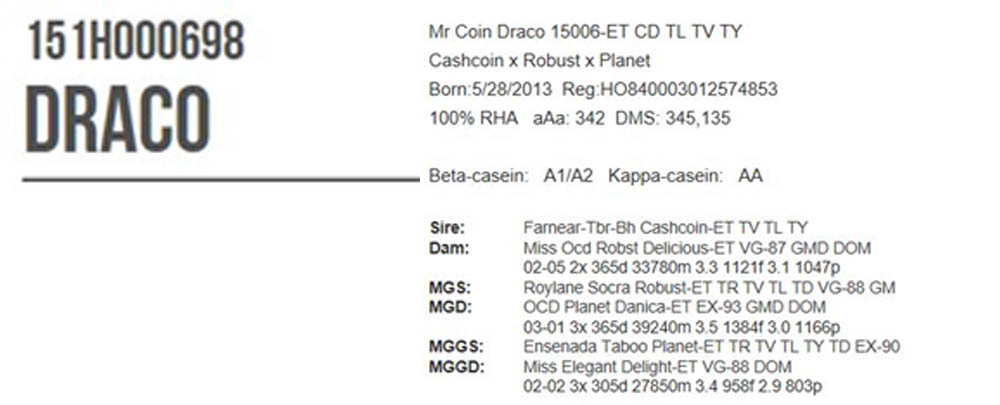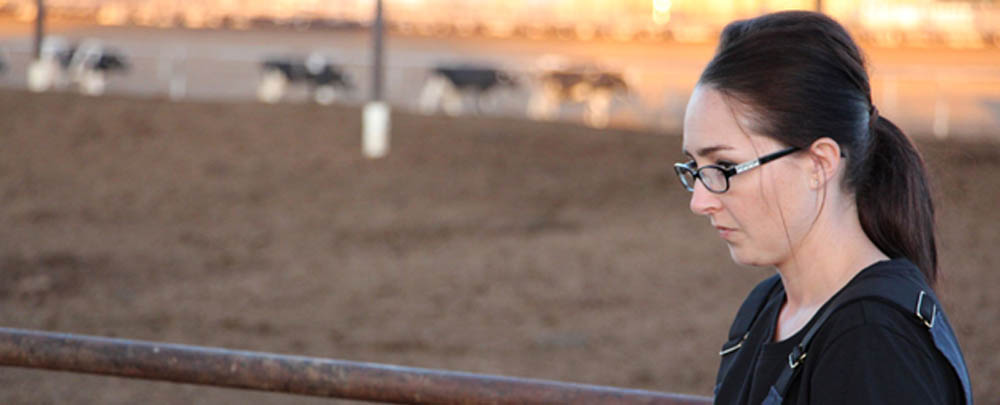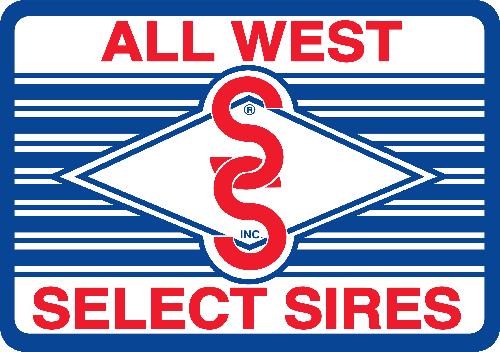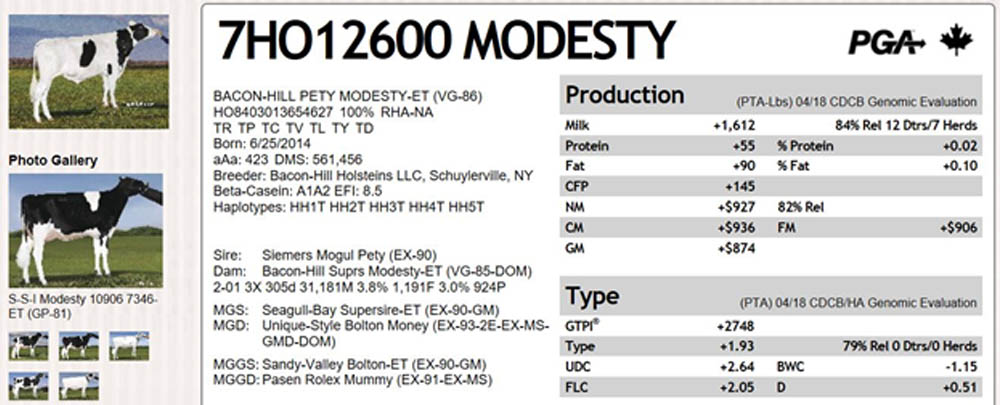 Q&A with All West’s Angie Kennedy
Q&A with All West’s Angie Kennedy
Now more than ever, dairy producers have never-ending “To Do Lists” on the farm, from the day-to-day raising of their livestock and producing of milk, to the pile of bills to pay and regulations to follow. In the midst of what sometimes seems like chaos, most breeders still find time to investigate before making reproductive choices that can affect the future of their herd’s genetics and their eventual financial stability.
These days, it seems even more rely on their genetic advisers, whether that be All West/Select Sires or another bull stud, to do much of the work for them by offering sire choices that will strengthen their herd in all the right areas as opposed to weakening their bottom line.
Yet there are still some studs who overlook the importance of taking haplotypes and recessive traits in to consideration when breeding and marketing their bulls. Improving the numbers on a bull’s proof, whether focusing on Type, Milk, Protein or elsewhere, is relatively easy, but it’s also easy to get wrapped up in increasing the numbers while consequently neglecting close examination of potentially damaging recessive traits.
Although these traits may not seem like an issue for your farm right now, we want our customers to be aware of the potential challenges that recessive traits can pose, as more are likely to develop in the future. We recently caught up with All West SMS Evaluator, Angie Kennedy, to ask questions and get answers while discussing her concerns about the haplotype for Cholesterol Deficiency.
First, what do all of the letters and codes by a bull’s name mean?
“All cattle have recessive and dominant traits, specific to each breed. These conditions are labeled with specific codes on the animals’ pedigrees and genetic evaluations. The letters that make up each code signify the genes that an animal is passing on to the next generation. The codes occasionally give us insight as to how the calf is going to look and often tell us if the resulting offspring have a chance of developing health issues and their risk of early death.
If the code for a dominate gene is present, that means that animal expresses the trait. If an animal carries a recessive trait, it means that animal is a carrier of that trait, but does not actually express it. As dairy breeders know, not all traits are negative. For example, naturally polled is a dominant trait that is selected by producers who desire hornless cattle. Another example of a potentially positive trait is red coat color in Holsteins. However, more recessive than dominant traits are known in the Holstein breed and most are known to be undesirable. More information about genetic conditions and a complete listing of these traits can be found here.
Let’s look at 7HO12600 Modesty, the recessive traits are: TR TP TC TV TL TY TD.
| TR | Tested free of Red Hair Color |
| TP | Tested free of the Polled Condition |
| TC | Tested free of Cholesterol Deficiency |
| TV | Tested free of CVM |
| TL | Tested free of Blad |
| TY | Tested free of Brachyspina |
| TD | Tested free of Dumps |
The “T” represents free of the haplotype, and “C” represents that the animal is a carrier of the specific haplotype. In this Modesty example, he is tested free of Cholesterol Deficiency. The numbers next to the H’s represent the haplotype. HH1T means that he is free of Haplotype 1, but HH1C would mean he was a carrier for Haplotype 1. To learn more about how each recessive haplotype affects fertility, click here.

In the case of the STgenetics’ bull, 151HO00698 Draco, his recessive traits are: CD TL TV TY. You can see in this example that Draco is a carrier of Cholesterol Deficiency.
| CD | Cholesterol Deficiency |
| TL | Tested free of Blad |
| TV | Tested free of CVM |
| TY | Tested free of Brachyspina |
Now we know how to read these codes, but why should we care about them?
“In most instances, the bull population is free from recessives that will have a negative impact on your herd, but it’s still good to double check the bull’s proof, especially if you’ve been noticing that your genomic test results have been coming back with some carriers. We have been aware of and tested for some of these recessive traits for ages, yet others are relatively new, and inevitably the researchers working on the bovine genome will discover more in the future. The more information we have, the more efficient we can be today!
The Haplotype for Cholesterol Deficiency (CD) is relatively new and is the most unnerving to me. I think all breeders should be aware of CD.”
So, what is Cholesterol Deficiency?
“Cholesterol deficiency, a new autosomal recessive inherited genetic defect in Holstein cattle, has been recently reported to have an influence on the rearing success of calves. The affected animals show unresponsive diarrhea accompanied by hypocholesterolemia and usually die within the first weeks or months of life.”
A transposable element insertion in APOB causes cholesterol deficiency in Holstein cattle
- Menzi N. Besuchet‐Schmutz M. Fragnière S. Hofstetter V. Jagannathan T. Mock A. Raemy E. Studer K. Mehinagic N. Regenscheit M. Meylan F. Schmitz‐Hsu C. Drögemüller
“Basically, the calf is born, looking healthy, yet cannot gain weight due to the issues described above and as a result, dies as a young calf. Besides the loss of the calf, which was meant to be part of the next generation of your dairy, what a financial loss! Cited in an extensive study conducted by Albert De Vries, the average value of a new pregnancy is $278, while the average cost of a pregnancy loss is $555. You’ve waited nine months for the next generation to be born and then it dies, affecting your operation’s bottom line as a whole.
Brachyspina (BY) is another recessive resulting in the loss of a calf by way of embryonic death, stillbirth and/or other deformities. It is estimated that 6% of the Holstein population are carriers of this gene.”
How common is this trait and do you see it becoming more common in the future?
“It is not very common, but as carriers continue to be identified, and those bulls are used in herds, we’ll inevitably breed more Cholesterol Deficiency carriers in to the breed.”
As a breeder, how can I avoid the risk of this happening in my herd?
“Thankfully, each haplotype is unique and does not pose a risk if a bull is a carrier for one and the dam is a carrier for another. The dam and the mating sire have to both be carriers of the same haplotype in order for the embryo to be affected. Again, in most instances, the bull population is free from recessives that will have a negative impact on your herd, but it is still wise be aware of their effects.”
The table below, provided by Select Sires Inc., shows the frequency of the different haplotypes and when the pregnancies are lost. The first letter represents the breed that the haplotype affects. The column on the far right details the timing of pregnancy loss when two carriers are bred to each other.
| Name | Key Sire Fathers | Haplotype Frequency | Timing of Pregnancy Loss |
| HH1 | Chief, Mark, Lindy, Formation, Finley, Throne, Jordan-Red, Palemo | 4.5% | All Stages |
| HH2 | Outside, Boulet Charles, Colby, Million, Mr Burns | 4.6% | Before Day 100 |
| HH3 | Glendell, Rotate, Emory, O Man, Boss Iron, Snowman | 4.7% | Before Day 60 |
| HH4 | Besne Buck, Jocko Besne | 0.7% | Unknown |
| HH5 | Thornlea Texal Supreme | 4.8% | Before Day 60 |
| JH1 | Top Brass, Sooner, Beretta, Hallmark, Paramount, Jace, Louie | 23.4% | Before Day 60 |
| BH1 | Stretch Improver, Emory, Prelude, Even, Earnest T, Peeless, Vigor | 14.0% | Before Day 100 |
| BH2 | Rancho Rustic My Design | 20.5% | Stillborn Calves |
| AH1 | Sellwood Betty’s Commander | 26.1% | Unknown |
Accompanying the chart in Select Sires Inc.’s article, Haplotypes Impacting Fertility, are these comments:
The impacts of these haplotypes vary and are dependent on their frequency in the population and at what stage of gestation the pregnancies are lost. Haplotypes with a higher population frequency and those that cause pregnancy loss later in gestation lead to larger losses of profitability. It’s important to realize that the negative impact of these haplotypes is already accounted for in the routinely published sire conception rate (SCR) evaluations and daughter pregnancy rate (DPR) genomic evaluations. So, if you are using these traits in selecting you’re A.I. sires you’re already avoiding or compensating for these genetic conditions.
The haplotypes each represent a distinct and unique genetic condition. They are not related to each other. The haplotypes have no impact when a bull that is heterozygous for HH1 is mated to a cow that is heterozygous for HH2. The risk is only experienced when animals are heterozygous for the same haplotype.
Unlike previous haplotypes that cause early embryo loss, the CD haplotype creates a greater economic loss. The defective haplotype traces back to Maughlin Storm. Storm’s sire and maternal grandsire do not carry HCD. This suggests that HCD is a result of a recent mutation that first appeared in Storm or his dam. Influential descendants of Storm that also carry HCD are Stormatic, September Storm and Goldwyn. Unfortunately, the haplotype carrying the defect is difficult to track. Part of the difficulty is caused because descendants of Comestar Laurie Sheik and Comestar Outside appear to have the HCD haplotype but do not appear to produce affected calves. For animals that have the haplotype and have both Storm and Outside in their pedigrees, it’s difficult to know whether they transmit the defective condition or not. Animals that don’t have the haplotype will be labeled as non-carriers. Animals that have the haplotype and it’s determined the haplotype came from Storm will be labeled as carriers. Those animals that have the haplotype and it’s determined the haplotype came from Outside will be labeled as non-carriers. Those animals that have the haplotype and it can’t be determined whether it came from Storm or Outside will be labeled as suspect. Heterozygous (carrier) animals may have reduced cholesterol levels, but homozygotes have no cholesterol and survive only a few months after birth.”

What programs does All West offer to help avoid haplotypes impacting fertility?
“If you’re allowing All West’s Select Mating Service (SMS) to assist you with mating your cattle, your herd is already being protected because our system will not allow two potential carrier animals to be mated to each other. Not only are you correcting the dams’ faults, you’re protecting for inbreeding and watching for harmful recessive traits.”
What do I do if I have already used one of the sires who is a carrier in my herd?
“Again, if you are letting our team mate your animals, this should not be an issue because our program will not allow us to mate a carrier to another potential carrier. However, if you are not using mating, then you need to avoid using carriers for at least one generation. Otherwise, you are taking a gamble at your herd’s own risk!”
Efficiency is extremely important to be profitable in the dairy business, especially considering today’s industry climate. By understanding haplotypes and the effects of recessive traits, you can continue improving the performance of your herd. Thank you to Angie Kennedy for sharing her knowledge and experiences with us! Contact your local All West Representative today to ask questions pertaining to haplotypes and recessive traits, learn more about reproductive efficiencies, and explore the mating services that All West/Select Sires offers.


 .
. .
. .
. .
. .
. .
.